There's a lot more to transportation-related carbon emissions than tailpipe exhaust, and merely swapping electric vehicles for internal combustion will not be enough to save our civilization.
By John Loukidelis
Published July 30, 2019
Our planet is heating up, but our ardour for the car shows no sign of cooling. In Ontario, since around the time of the first Intergovernmental Panel on Climate Change (IPCC) Report in 1990, we have spent more time driving further and in bigger vehicles as we go about our daily routines.
During the time we have known about climate change and the impact it would have on our planet, Ontario's transportation-related emissions rose by 34 percent, 'helped' in part by our purchase of the most inefficient vehicle fleet in the world.
One might suppose that the electric vehicle (EV) will help with this problem. Tesla seems to think so. "Tesla exists for one reason: to accelerate the world’s transition to sustainable energy," said one spokesperson for the company. On this view, Tesla's cars are one of the keys to a sustainable future unclouded by the threat of climate change.
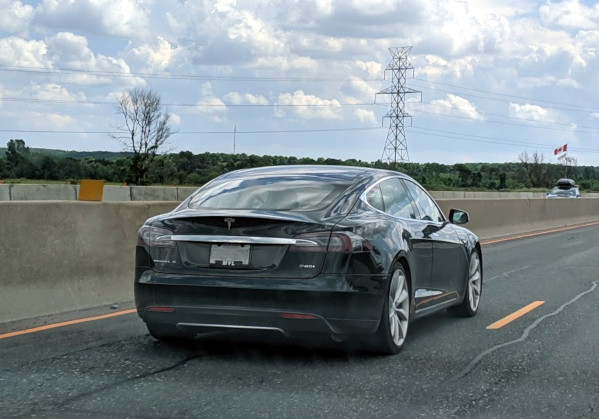
Tesla Model S (RTH file photo)
Is that true? Let's assume for the moment that we were serious about EVs. (This is, I know, a highly questionable assumption, given our current fascination with light trucks.)
Our civilization has a carbon budget. We can emit only so much more carbon dioxide (CO2) before we alter the biosphere in a way that is incompatible with the health and well-being of that civilization.
It's like we have been given a backpack to load with supplies and told to march across a desert without the hope of finding more water or food on the way. Only so many things can fit in the backpack, and so we need to be extremely careful about what we put in it, if we are going to survive the journey. We can't afford to pack Coke; we need to pack water. We can't afford to pack Bugles; we need to pack Red River cereal instead.
Tesla appears to want us to believe that the electric car - if it replaces the fossil-fuel version - will fit in the backpack. The facts and figures, however, suggest that a car-oriented transportation system, even one that is dominated by EVs, is junk food we can no longer afford to carry.
The IPCC seems to agree. In its special report from the fall of 2018 (SR15), the IPCC said the following about the 1.5°C target and the transportation sector (at sec4.3.3.3 of SR15):
Urban form impacts demand for energy (Sims et al., 2014) and other welfare related factors: a meta-analysis of 300 papers reported energy savings of 26 USD per person per year attributable to a 10 percent increase in urban population density (Ahlfeldt and Pietrostefani, 2017). Significant reductions in car use are associated with dense, pedestrianized cities and towns and medium-density transit corridors (Newman and Kenworthy, 2015 [book]; Newman et al., 2017 [paywall])
[...]
Scenarios consistent with 1.5°C depend on a roughly 15 percent reduction in final energy use by the transport sector by 2050 relative to 2015 (Chapter 2, Figure 2.12).
[...]
Such a transition depends on cities that enable modal shifts and avoided journeys and that provide incentives for uptake of improved fuel efficiency and changes in urban design that encourage walkable cities, non-motorized transport and shorter commuter distances
[...]
[Transit-oriented development] is important to counter the rising demand for private cars in developing-country cities (AfDB/OECD/UNDP, 2016).
SR15 isn't saying that the private automobile must disappear. It does seem to be saying that we can't meet our emissions targets if all we do is swap our internal-combustion engines for electric motors but continue with a car-centric transportation system.
EVs everywhere are unlikely to be consistent with 1.5°C. We won't be able to fit that many of them in the backpack because of some basic facts about what it takes to move people.
In the universe we inhabit, moving people takes energy. To understand how much energy, we must recognize some basic facts about vehicles.
First and foremost, it takes more energy to move people a longer distance and less energy to move them a shorter distance. (I knew grade 13 physics would come in handy some day.) Part of the reason that flying is emissions-intensive is that people are typically moving a long distance when they fly. Likewise, if we need to drive longer distances, we will consume more energy doing so.
In addition, moving a bunch of people in cars (electric or not) will never be as efficient as moving them in a bus or a train, operating at something like capacity, because the frontal area of the vehicle per person - the air resistance - will be so much higher for cars, especially when the car only has one or maybe two people in it, as is so often the case when we Ontarians commute to work.
Similarly, moving a person who can't walk somehwere means putting that person in or on a vehicle that itself has mass. The greater that mass, the more energy it takes to move the person and the vehicle. Again, a bus or a train operating at a reasonable capacity will always beat a car in this regard.
What does all of this look like in practice? According to Sustainable Energy - Without the Hot Air, the Croydon Tramlink (an LRT-like system) moved people at an energy cost of about 9 kWh per 100 passenger-kilometers or "p-km". On the other hand, a typical fossil car in the UK with one person in it got about 80 kWh per 100 p-km. (And keep in mind that the UK has a significantly more efficient vehicle fleet than we do here in Canada.)
Even an EV uses more energy: a Tesla supposedly gets something like 15 kWh per 100 km. That's much better than the typical UK car, but it's still about 66 percent higher than the tram.
Well that's fine, you might say. If the energy being used to move the person is delivered by electricity, and the electricity is coming from a "clean source", then Tesla wins, even if it is more energy-hungry. With cars, we will use more energy per p-km to move people around compared to using buses or trains, but that energy can come from renewables or some other low-emissions source. We get to put our cars in the backpack after all, thanks to the EV.
In Ontario, there is some truth to the idea that EVs can be a low-CO2 means of moving people because our power generation is relatively low-emissions, thanks in large part to our large nuclear fleet. More on that below.
That said, everything about transportation has an emissions cost, given our current technology. It's not just about the energy needed to move a vehicle from point A to point B. All emissions need to be accounted for when thinking about the transportation system for a 1.5°C world.
Building vehicles, building the roads or tracks on which vehicles move, the distances that vehicles need to travel and generating the energy needed to move the vehicles all have emissions consequences. Cars, even electric ones, when compared to transit or active transportation, are problematic across all of these dimensions.
An ION light rail vehicle (LRV) - a Bombardier "Flexity Freedom" - in Kitchener-Waterloo carries about 200 passengers. Let's say that one vehicle typically operates at only 40 percent or 50 percent capacity and that it weighs 48 tonnes (48,000 kg, or 105,822 lbs).
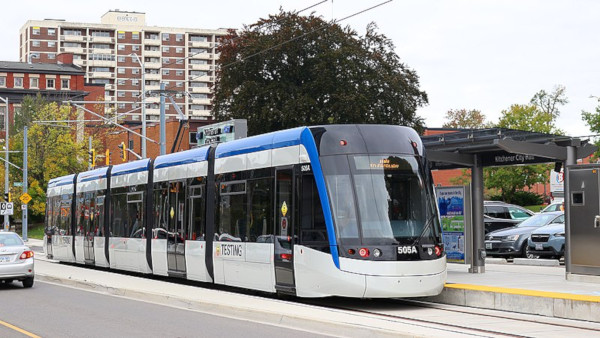
Waterloo ION LRT vehicle (Image Credit: Wikimedia Commons, licenced under Creative Commons Attribution-Share Alike 3.0 Unported)
To move the same number of people might take 80 Model 3 Teslas. A 'light' version of the Model 3 weighs about 1.6 tonnes. That is, to move the same number of people, Tesla must manufacture vehicles with a total weight of about 128 tonnes. That's a lot more stuff.
It's probably worse than that, however. EVs are easier to maintain and should last longer than their combustion-engine cousins. Nonetheless, they will likely not last as long as LRVs. Some of the Calgary LRVs clocked 3,000,000 km before heading to the scrapyard.
Let's say that a Tesla Model 3 will be able to last for 1,000,000 km. That's probably very optimistic - one article on EV emissions assumes a vehicle lifetime of only 150,000 km for a Tesla 3 - but let's give Tesla the benefit of the doubt. In that case, to move the same number of people, Telsa will need to manufacture vehicles with a total weight of about 384 tonnes, or about eight times the 'stuff' needed for the ION LRV.
Extracting, refining, manufacturing, assembling and moving vehicles from maker to user all have emissions costs. Just building the batteries for EVs has significant emissions consequences (not to mention other environmental impacts).
Most estimates of the emissions associated with the manufacture and use of an EV show that they are significantly better than conventional cars. (Although it appears to matter a lot where the vehicles and the batteries in particular are produced.) But the CO2 footprint of putting the EV on the road is still far from zero.
For a low-end Model 3 (that is one with a 50 kWh battery), the total emissions associated with making the battery (never mind the rest of the car) will likely be somewhere in the neighbourhood of 4.4 tonnes of CO2 (assuming that the process is efficient and the source of energy used is green-ish).
To move the same number of people, we will need to put a lot more stuff (more manufacturing-related emissions) in our backpack, if the transportation system remains focused on the car.
Of course, you need roads or rail on which vehicles can move, and those have emissions consequences too.
Building and maintaining roads have significant carbon emissions associated with them. One study [PDF] found that building a "hot mix asphalt" (HMA) roadway in a residential area generates about 64.5 tonnes of CO2/km of roadway. Building an HMA collector road generates about 170.1 tonnes of CO2/km. Building an HMA freeway generates an astonishing 346.8 tonnes of CO2/km.
Over the 50-year lifespan of that freeway, maintenance will generate another 153.1 tonnes of CO2/km, for a total of almost 500 tonnes of CO2/km. The lifecycle emissions of a Portland cement concrete pavement freeway is 1,610.4 tonnes of CO2/km. By way of comparison, each Canadian emitted about 18.62 tonnes of CO2 in 2016.
Of course, public transit infrastructure comes with a carbon footprint too. An LRT railway must be built of sturdy stuff to handle the heavy vehicles that will travel over them. That means using a lot of steel and concrete, both of which take a lot of CO2 to produce (see below).
A University of Toronto research team found that it might take as much as 33 years for the Sheppard subway to 'go negative' emissions-wise. It might take 33 years for the emissions savings from the line to offset the emissions from its construction and operation.
But you can move many more people in a relatively small space using public transportation compared to cars. You will need to emit CO2 to build an LRT line, but that LRT line will transport many more people than the roads and highways that compete with it.
Put another way, you will need to emit a lot of CO2 building roads and highways to transport the same number of people as an LRT line. Again, to move the same number of people, we will need to put more stuff (construction-related emissions) in our backpack, if we continue to rely on the car as the main method for moving people.
Public transportation has another advantage over cars. It supports and is supported by a more compact urban form. You will need fewer roads and railways - you will need less stuff - in such a city. And chances are, you won't need to travel as far, either, if your world isn't car-dominated.
Cars take up a lot of space. They are not a space-efficient means of moving people, and they need to be stored somewhere when they're not in use. In a transportation system built around cars, you will need (or you will end up with) suburbs, suburban malls, office parks (tall buildings surrounded by huge parking lots), large parking lots generally and lots of multi-lane highways and "stroads".
We have all seen those photos of the space taken up by cars moving 200 people compared to the space taken by the LRV or buses needed to move that same number.
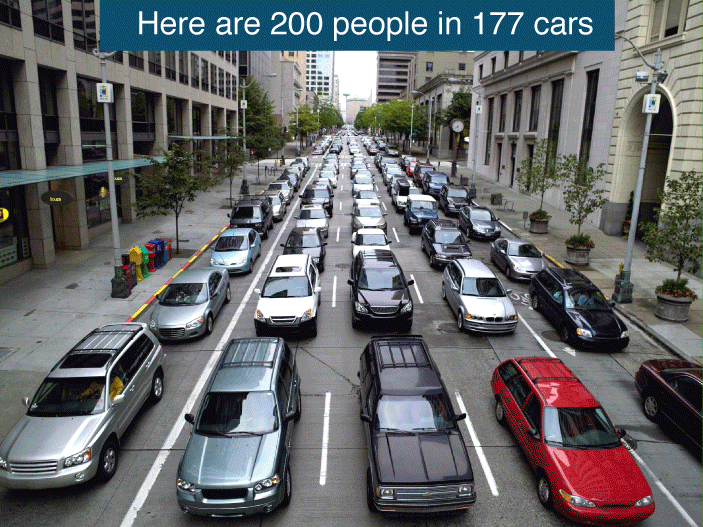
Space required by 200 people in cars, on bikes, on buses and in LRT (Image Credit: Washington Post)
Where cars dominate, so does sprawl. One could argue about cause and effect. Do we have sprawl because we have cars, or is it the other way around? In any event, sprawl means we must drive longer distances and spend more time doing it (because of traffic) to get anywhere.
In Ontario, between 1990 and 2016 our per capita road travel by car went up ten percent. Overall, Ontario's passenger-kms increased 47 percent between 1990 and 2016. The province's population increased significantly in that time as well, but many of those additional people had no choice but to get into a car to go about their daily lives. The distances Ontarians drove, then, went up dramatically as well.
Transit-oriented development supports cities where people need to travel shorter distances. This has two important consequences. The first is that we need fewer and shorter roads in compact cities. As a result, the total emissions associated with building and maintaining the roads and other transitways are lower. A city that needs only 10,000 km of roadway will have lower emissions than one that needs 30,000 km.
The second major benefit of a compact city is that its inhabitants can get places without travelling long distances. The energy-use figures given above for the tram and the Tesla (9 kWh per 100 p-km vs 15 kWh per 100 p-km) seem pretty close to each other. That proximity doesn't mean much, though, if the Tesla must drive longer distances.
If our intrepid commuter lives in the sprawl and must drive 50 km each way to work every day, she will use 15 kWh of energy daily to do so in her EV. If that same commuter lived in a compact city and could take the LRT only 10 km each way per day to work, then her energy usage for transport would be a mere 1.8 kWh.
Her energy consumption in the Tesla wouldn't be just two-thirds higher; it would be more than eight times higher. Our commuter's emissions backpack will fill up that much faster, if she must travel longer distances in sprawl.
The actual energy consumption of an EV, rather than its theoretical rating, matters a lot. Generating electricity has emissions consequences as well. A Tesla doesn't emit anything when it's operating. It has no tailpipe. But producing the energy needed for its battery and transporting it to the place where people need to use it both have carbon footprint consequences.
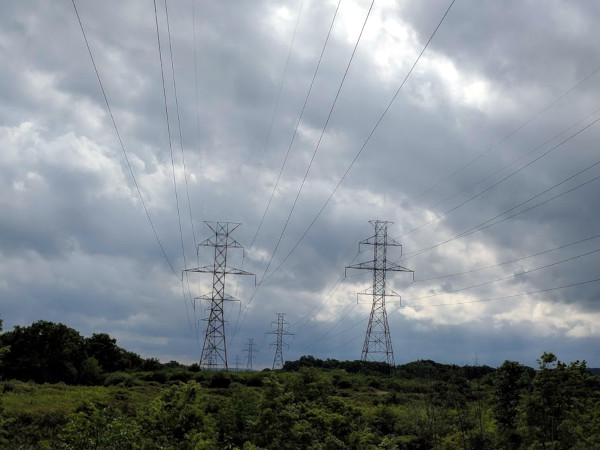
Electric transmission lines in Ontario (RTH file photo)
If the electricity for an EV's battery comes from a coal-fired plant, then EVs don't look quite so good from an emissions perspective.
Low-emission or 'green' sources of electricity generation will help with that picture, but they still take up space in the backpack. Even nuclear and renewable energy power generation (wind and solar) have a carbon footprint. It takes a lot of steel and concrete to build a nuclear reactor.
When it's operating, a nuclear reactor doesn't produce any CO2 directly. (Mining and refining fuel for a reactor does produce some emissions, but not a lot because the amount of fuel used by a reactor is relatively small.) To build a 1 GW reactor, however, you might use 520,000 cubic metres of concrete and 67,000 tonnes of steel.
Making concrete and steel using current technology generates a lot of CO2. By some estimates, about 8 percent of global CO2 emissions are derived from concrete production. As a result, the carbon emissions of nuclear power are something like 12 g/kWh(e).
Onshore wind energy is no better. Again, while it's operating, a turbine does not produce any CO2. Manufacturing and installing the turbine do produce emissions, however. It takes a great many turbines to generate the same amount of electricity as a reactor (for example), and it takes a lot of steel and concrete to put them all into operation. The total carbon emissions of onshore wind energy is about 14 g/kWh(e), according to some estimates.
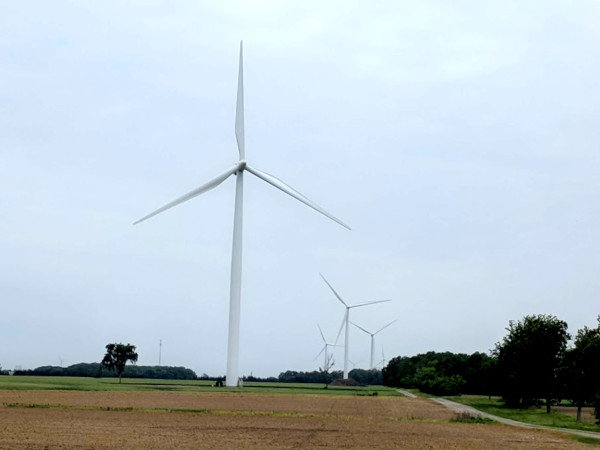
Wind turbines in southwest Ontario (RTH file photo)
Solar's emissions are even higher: it's footprint is around 41 to 48 g/kWh(e).
Both of these estimates come from older sources, and a lot has changed in renewables just in the last decade. The point remains, however, that not even wind or solar are emissions-free.
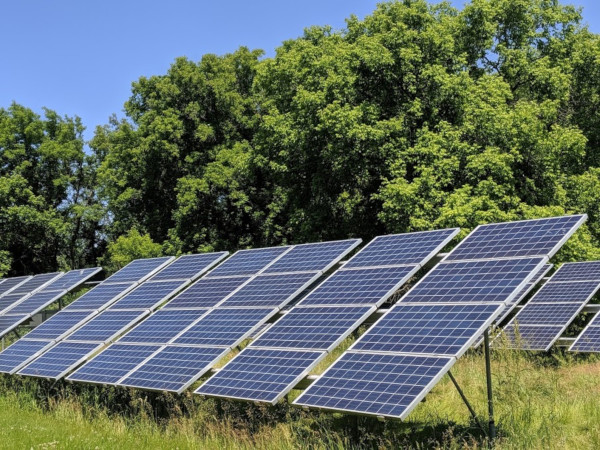
Solar panels in Brantford (RTH file photo)
In any case, Ontario's grid on the whole is more carbon-intensive than emissions of only 12 to 14 g/kWh(e). According to the National Energy Board, in 2017 Ontario's carbon footprint for electricity was about 40 g/kWh(e).
To go back to our Tesla driver vs the LRV passenger, if the Tesla driver is commuting 50 km each way in Ontario, then she is emitting 15 kWh × 40 g/kWh or about 600 g of CO2 every day to do so. If she can get in an LRV and commute 10 km each way instead, she will emit only 72 g of CO2 during her journey.
With our current technology, everything has a carbon footprint. Given a typical diet (ie one that includes eating meat and dairy), an average person will generate about 42 g of CO2 by walking one kilometre. If that person rides a bike instead, he will generate only 30 g of CO2, but don't forget that they need a road to ride on and that the bike they ride 'embodies' emissions as well. Building and maintaining the road, making the steel and aluminum for the bike, putting the bike together and then shipping it to the cyclist - all of those things generate CO2.
There is a special kind of idiot on Twitter who thinks that these facts constitute an argument against climate change or against taking action on climate change. Someone smarter will want to consider these facts carefully in light of our remaining carbon budget. Given these facts, what can we afford to put in our backpack?
The facts and figures given above suggest that even EVs will emit too much CO2 for the backpack, if we simply swap them for fossil-fuelled vehicles in our current urban form.
Compared to active and mass transit, cars are inherently energy inefficient. It takes too much stuff to build them and too much stuff to make the roads they need to travel. It takes too much energy to move them over the longer distances they inevitably travel. The stuff and the energy all have emissions consequences, and so, even with a 'green grid' and 'green cars', a car-oriented transportation system will emit more CO2 than the remaining budget can afford.
By 2050, when we need net zero emissions (SR15, C.1), we will need a transportation system where the average person emits something more like 72 g of CO2 to commute to work each day rather than 600 g.
There were about 22.4 million light vehicles in Canada in 2016. Replacing all of those vehicles with EVs while keeping our current urban forms in place won't get us to where we need to be. Rather, by going that route, we will emit enormous amounts of CO2 making the EVs and maintaining (or, God forbid, even expanding) the roads of the sprawl.
And we will emit all of that CO2 and then find that we must emit yet more CO2 to build the kinds of cities and transportation systems that are consistent with a truly sustainable transportation system. The question is, will we have enough time and enough of a carbon budget left by then to make that second transition?
By grok (registered) | Posted July 30, 2019 at 13:22:27
This technical essay (amongst other assumptions) not only assumes an 'inclusive' 'We', which can only be the reflection of unsupported assertions of bourgeois class hegemony over the working-class and all the rest of us; it also clearly and obviously (and blithely) assumes the very Capitalist order itself: as 'The Solution' to the VERY problems which this criminal, exploitative order has itself created, no less. A World order of exploitation and mass-murder which remains clearly in a deepening World crisis -- out of which many of us do NOT expect it to recover, in fact.
The COUNTER assertion to the assumed assertions in this article, is this: that the ACTUAL solution to ALL the burgeoning crises of Capitalism..?? Remains SOCIALISM. Pure and simple. Because 'We' MUST get rid of 'The Profit Motive'/'The Free Market' as the basis of all social decision-making, in order to achieve ANY meaningful social goals. THAT should be quite obvious to any honest Human being, by now.
And so: you don't sweat the details. YOU GO FOR SOCIALISM. ALL the rest follows. ALL of it.
Only the self-absorbed middle-classes care only about any low-hanging, sweet fruit, which can benefit primarily only THEM.
By ergopepsi (registered) | Posted August 02, 2019 at 00:33:55 in reply to Comment 130268
This reply should be read in street preacher voice while imagining yourself standing on a milk crate in dirty pants and soiled white running shoes.
You must be logged in to comment.
There are no upcoming events right now.
Why not post one?